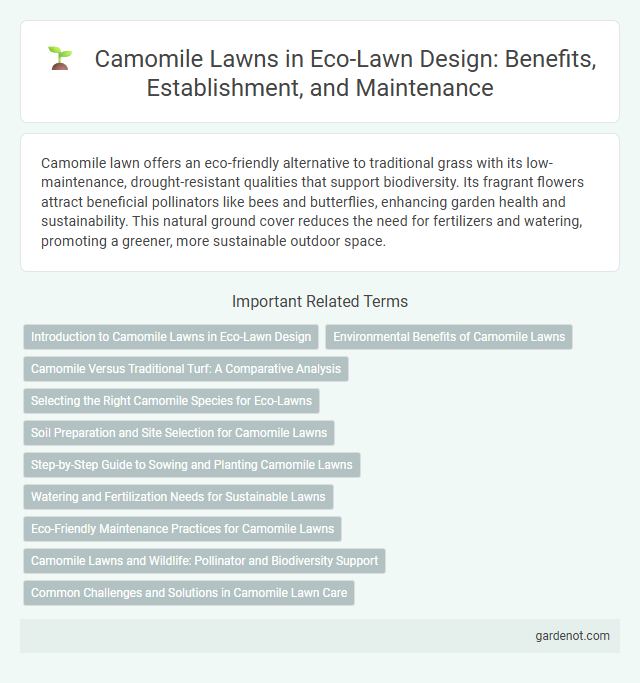Camomile lawn offers an eco-friendly alternative to traditional grass with its low-maintenance, drought-resistant qualities that support biodiversity. Its fragrant flowers attract beneficial pollinators like bees and butterflies, enhancing garden health and sustainability. This natural ground cover reduces the need for fertilizers and watering, promoting a greener, more sustainable outdoor space.
Introduction to Camomile Lawns in Eco-Lawn Design
Camomile lawns offer a fragrant, low-maintenance alternative to traditional grass, thriving in well-drained soils with moderate sunlight. Their drought tolerance and natural pest resistance align with eco-lawn principles, reducing water usage and chemical inputs. Integrating camomile into eco-lawn design enhances biodiversity while providing soft, resilient ground cover ideal for sustainable landscaping.
Environmental Benefits of Camomile Lawns
Camomile lawns contribute significantly to environmental sustainability by enhancing soil health through nitrogen fixation and organic matter accumulation. The dense, low-growing foliage reduces erosion, supports local pollinators like bees and butterflies, and requires minimal watering compared to traditional grass lawns, promoting water conservation. Their natural pest-repellent properties decrease the need for chemical pesticides, fostering a healthier ecosystem.
Camomile Versus Traditional Turf: A Comparative Analysis
Camomile lawn offers a fragrant, low-maintenance alternative to traditional turf by providing natural pest repellent qualities and improved soil health through nitrogen fixation. Unlike conventional grass lawns, camomile requires less frequent mowing and watering, reducing environmental impact and conserving resources. Its drought-resistant nature and ability to support pollinators make camomile an eco-friendly choice for sustainable green spaces.
Selecting the Right Camomile Species for Eco-Lawns
Choosing the right camomile species for eco-lawns involves balancing aesthetic appeal with environmental benefits. Matricaria chamomilla, known for its drought resistance and fine texture, thrives in eco-lawn conditions while requiring minimal maintenance. Alternatively, Chamaemelum nobile offers a fragrant, low-growing option that supports pollinators and enhances soil health in sustainable lawn ecosystems.
Soil Preparation and Site Selection for Camomile Lawns
Camomile lawns thrive best in well-drained, sandy or loamy soils with a neutral to slightly acidic pH of 6.0 to 7.0. Selecting a sunny to partially shaded site ensures optimal growth, as camomile requires ample sunlight for healthy foliage and flower production. Proper soil preparation, including removing weeds, loosening the soil to a depth of 15-20 cm, and incorporating organic compost, enhances water retention and nutrient availability essential for a lush camomile lawn.
Step-by-Step Guide to Sowing and Planting Camomile Lawns
Sowing a Camomile lawn requires well-drained soil and full sun exposure for optimal growth. Begin by loosening the soil to a depth of 10-15 cm, then evenly scatter Camomile seeds while lightly pressing them into the soil without covering completely. Water gently to keep the soil moist until germination, which typically occurs within 7-14 days, and maintain regular watering to establish a lush, fragrant lawn that thrives with minimal mowing.
Watering and Fertilization Needs for Sustainable Lawns
Camomile lawn requires minimal watering, thriving best in well-drained soil with occasional watering during prolonged dry spells, making it ideal for water conservation. Fertilization needs are low; a light application of organic compost or slow-release, nitrogen-rich fertilizer once in early spring supports healthy growth without promoting excessive lushness that can harm the plant's drought tolerance. Sustainable maintenance of camomile lawns focuses on balanced moisture and nutrient inputs to preserve their natural resilience and ecological benefits.
Eco-Friendly Maintenance Practices for Camomile Lawns
Camomile lawns thrive with eco-friendly maintenance practices such as minimal mowing, which supports biodiversity and reduces carbon emissions. Using organic fertilizers and natural pest control methods preserves soil health and avoids chemical pollution. Regular hand-weeding further promotes a sustainable lawn environment by preventing herbicide use while enhancing the camomile's natural growth.
Camomile Lawns and Wildlife: Pollinator and Biodiversity Support
Camomile lawns provide essential nectar and pollen resources for pollinators such as bees and butterflies, enhancing local biodiversity and supporting ecosystem health. The dense, low-growing camomile plants create a habitat that encourages beneficial insects and small wildlife, promoting a balanced and resilient environment. Integrating camomile into eco-lawns contributes to sustainable gardening practices by reducing the need for chemical inputs and fostering natural wildlife corridors.
Common Challenges and Solutions in Camomile Lawn Care
Common challenges in camomile lawn care include weed invasion, fungal diseases, and drought sensitivity. Effective solutions involve regular weeding, applying organic fungicides, and ensuring consistent watering without waterlogging. Maintaining well-drained soil and using mulch can also enhance camomile lawn health and resilience.
Camomile lawn Infographic

 gardenot.com
gardenot.com